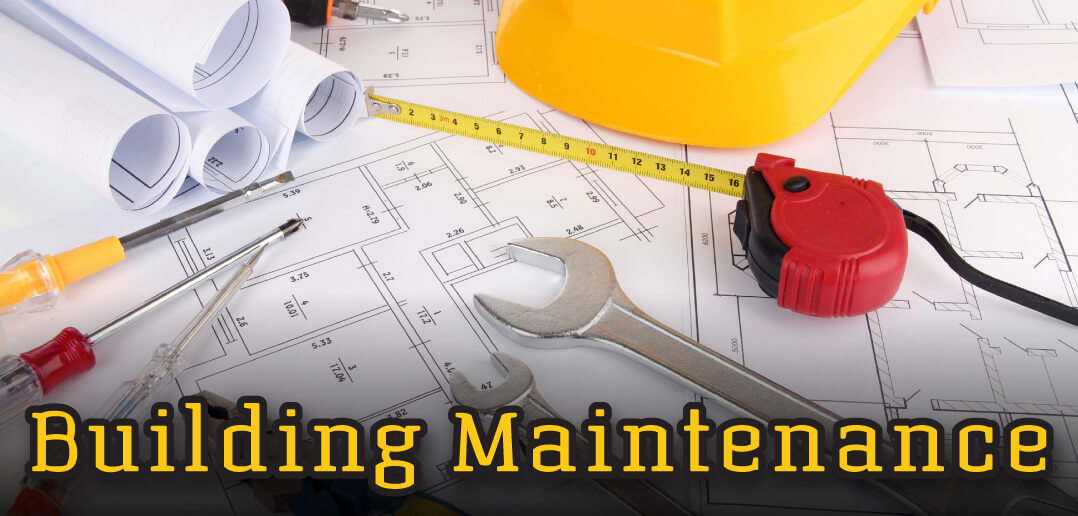Building Maintenance in Omaha, NE 2018
There’s little more important for a commercial property owner as well as for the occupants of a building, or tenants when applicable, than the proper building maintenance being performed on a regular basis. Ideally, if this is done correctly, business is conducted as usual and it goes without notice for the most part. However, on the other hand, if not kept up with as it should be, there are things that you will surely notice that are less than desirable, even dangerous and disastrous, for any number of reasons. This also translates into being more costly to repair or replace as opposed to protecting your investment and ensuring longevity by maintaining.
There are a number of variables to consider that have an impact on the building environment and operations within it. A maintenance schedule is a must, whether you’re performing the tasks or outsourcing the work.
For property owners, some will have a full team of professionals dedicated to building maintenance while others will do some of the items themselves and contract out the others to trusted professionals with whom they have developed a working relationship. For tenants, while there are some things you may be responsible for based on your lease, generally the majority of the items will be performed by property management.
There are several instances when communication regarding building maintenance is important. Understanding the history of maintenance is imperative when a property changes hands. It’s also important for property owners and their employees and professionals contracted to perform maintenance to be on the same page. For property owners and tenants, it’s more about clearly defining who is responsible for what and bringing attention to any concerns as soon as possible.
All told, building maintenance is one area where being proactive can save you from major mechanical breakdowns or excessive depreciation. Below you’ll find a basic list of items that, while not exhaustive, are all important to have checked or performed on a regular basis in order to keep your building functioning at all times.
- Fire Alarm and Sprinkler System Testing
- Sump Pump – Check Connections, Winding Motors, and Lubrication
- Water Pump – Domestic Water Circulating Pumps, Checks and Lubrication
- Dry Pipes – Air Compressor, Fire Compressor, Check for Leaks
- Garage Doors and Parking Gates – Lubrication, Adjustments of Beams, Pressure System Testing
- Exhaust, Supply and Return Fans – Motor, Belts and Barometer Testing, Air Flow Testing in Supply and
- Return Vents
- Elevator – Belt and Pulley Checks and Load Testing
- Winterization of Pipes
- HVAC: Coil Cleaning, Filter Replacement, Evaporator/Condenser Changing, Belts, Line Clearing, Amp and
- Ohm Motor Testing, Condensate Pipe Checks, Air Flow Testing, and Water Flow Testing
- Emergency/General Building Management Systems Operation and Testing
Especially with respect to the importance of the first and last items on the list, Bob Sorensen with FireGuard, Inc. emphasizes, “It is imperative that building/property owners have knowledge of, and adhere to, the National Fire Protection Association (NFPA) codes and standards. Compliance helps maximize system integrity to avoid failure and ensure fast, effective response in a fire emergency.
FireGuard’s licensed, qualified, and experienced personnel are among the very best in what they do: inspection, testing, and maintenance of all fire protection systems.”
Sorenson also notes, “When planning and budgeting for the required inspections and maintenance of your building’s fire protection systems, you should expect quality, efficiency and reliability.
A key benefit FireGuard offers is that we keep track of when all of our customer’s inspections are due for them. When it comes time for a routine inspection or to be performed, we then call to schedule service at a time most convenient for the customer. This eliminates any inspection being missed or past-due. Our customers are always current on their inspections because of the detailed monitoring we provide.
FireGuard, Inc. not only offers the Priceless Protection you deserve, we provide peace of mind in knowing that in one phone call, any and all of your fire and/or life safety needs and concerns will be resolved. Life safety systems are too important to be out of service! FireGuard’s knowledgeable technicians are on-call and available to handle emergencies 24/7. When you call FireGuard, you will not get a machine; you speak with a real person – every time – who will dispatch a technician promptly. Whether downtime is scheduled or unscheduled, we have the skills and experience to minimize system service interruptions, which is imperative to keeping your business running.”
He concludes, “As your One Call One Source for all fire and life safety needs, FireGuard saves time and money in being able to handle all needs in-house. Eliminating multiple vendors saves on truck charge costs as well. We design, sell, install, and inspect all types of fire protection and life safety equipment, including: Fire Alarm Systems, Fire Sprinkler Systems, Special Hazard Systems, Fire Extinguishers, Fire Door Inspections, Restaurant Systems, Exit & Emergency Lights, Fire Appliances & Accessories and more! FireGuard truly handles it all.
Also, going back to NFPA codes and standards, they are constantly changing. FireGuard’s personnel are the experts who will walk you through and explain exactly what is required – and what is not – to ensure you are up to code and in compliance within your building. Please call (402) 592-1999 for a free consultation.”
Technology will come into play to some extent with any type of building maintenance in this day and age. It often is involved with what’s being performed to maintain components of your building. On the other hand, for the existing technology utilized within your building, whether it’s related to the maintenance of your building or other operations, it applies to your needs there as well.
System integration has become commonplace, opening up a world of options and with associated benefits that translate to building maintenance.
“Our goal is to make technology an afterthought for the client from a maintenance standpoint,” says Jason Muehlhausen with Echo Systems. “Selecting the proper system design is vital at the beginning of the process. Along the same lines, when we design an AV system it’s open-ended with the potential for growth. As our clients’ businesses grow and their needs change, modifications can easily be made.
Furthermore, if you’re making a significant investment in technology, it’s wise to enter into a service contract to maintain the newly-installed system. Far too often the value and savings a service contract offers during the life of an AV system are overlooked. We’re able to provide plenty of recommendations based on the individual client for asset protection and for optimal performance and longevity. Our system designs aren’t cookie cutter; they are designed based on the client’s system functionality requests. Extensive planning and research go into each design as well as our recommendations on what’s needed in the future to keep it well-maintained.”
He also notes, “We can offer every aspect of AV systems, lighting control, shading solutions, and security systems, which is an asset. One call to one technology service provider helps to ease our client’s minds. In some cases, clients will use multiple AV integrators based on price alone. I’ve seen examples of this and the client has gone through the pain of having to redesign, re-engineer and reinstall a completely different solution.
Also, beware of selecting the lowest-priced solution/integrator; you may save money now but it will probably cost you more money in the long run. In most cases the low-cost AV integrator installs the AV system, the job is done, and you rarely hear from them again. This term is commonly referred to as ‘Hang and Bang.’ Once the project is completed the service after the sale is usually non-existent.”
Muehlhausen also mentions a major trend for building owners to consider. “The addition of an AV control system with the capacity to monitor AV equipment over their internal network is one thing that I think is delivering particularly great results for our clients.”
Speaking of controlling the systems responsible for integral functions, Pat Killeen with Engineered Controls further advises, “Since Engineered Controls provides our customers with products for their buildings that serve the purpose of maintaining comfort, improving energy consumption, and providing a secure environment. Simply put, when it comes to our role in building maintenance, it is our job to make sure that the building’s mechanical and electrical control systems are functioning properly, as designed, and that everything is in good working order.
Building owners invest significant resources in environmental and building control systems. These systems can be costly to operate, yet essential for occupant comfort, productivity, and safety. Keeping systems operating at peak performance also reduces energy use and lowers utility costs, a growing concern for buildings owners worldwide.
Maintenance constitutes a significant percentage of expenses in most facilities and is therefore worth optimizing. Maintenance costs consume nearly as much of a typical building’s operating budget as utility costs and amount to more than one-third the total operating expenses.
Despite the importance and expense of maintaining building efficiency, most building owners, some 55% in the US alone, rely on reactive maintenance programs to care for their equipment. This means they wait until equipment fails completely before initiating corrective action. Realistically, reactive maintenance is not maintenance at all and should be called repair work.
This leaves approximately 45% of building owners who take the traditional preventative maintenance approach, which means performing regular, prescheduled maintenance checks and minor repairs. This approach yields the best results.
When building owners ignore routine preventative maintenance, building occupants’ comfort can be negatively impacted whereby this can lead to employee absenteeism, low productivity, or even worse, becoming sick.
Furthermore, building owners could also see energy efficiency degraded by as much as 10% to 30% over a one- to three-year period. Beyond its impact on energy efficiency, lack of maintenance can lead to equipment failures where equipment replacements can drive up the unbudgeted cost of capital expenses. This can also disrupt employee or tenant comfort and lead to equipment issues that pose a safety risk in a building. Besides equipment failures, the lack of building maintenance can compromise indoor air quality and unnecessarily increase energy usage. These kinds of problems can get more expensive the longer building maintenance is ignored.
A more efficient way to incur minimal costs and achieve maximum availability is to implement a service plan that uses proactive and predictive maintenance based on the actual condition of the equipment rather than a predetermined schedule. With this approach, equipment is maintained at a continuously high level of performance rather than waiting for something to fail. In addition, a predictive approach can be used to prioritize repairs and maintenance so that the most important systems, as judged by the building owner, are repaired first, ensuring the most effective return on investment.
The most efficient approach is to include progressive analytics to leverage the big data generated by today’s advanced Building Management Systems (BMS). This data provides accurate, timely, and actionable information that can be leveraged to refine service programs even further and achieve optimal building performance. Building owners can make data-driven decisions based on the impact that the recommended maintenance will have on the efficiency of a building’s performance.
For example, in a predictive maintenance program, key operating parameters of equipment are checked regularly by staff or monitored automatically by BMS sensors. The readings are then analyzed and used to evaluate the condition of the equipment and predict the future performance or likelihood of failure. This means that repairs are performed at the ideal time, resources are not wasted on unnecessary work, and the equipment is maintained at a higher level of performance.”
With much of building maintenance and repair being quite technical, even more so than one might think, it’s critical to carefully evaluate your options, and to involve a professional in that process. Their take on things and guidance when you’re making decisions about how best to handle it is invaluable.
To illustrate yet another excellent example of this, Steve Van Gorp with McGill Restoration discloses, “We specialize in restoration, which goes hand in hand with preservation. As such, we do a lot of work in buildings specific to structural integrity. With my extensive experience in the coating industry, I’ve seen the good, the bad, and the ugly. As such, I can fully attest to the importance of investing in the use of the proper methods and materials to maintain your building.
Specifically with anything that’s composed of structural steel, coating serves the purpose of protecting from corrosion. Parking garages, for example, are especially prone to accelerated corrosion given frequent traffic and along with it, heightened exposure to the deicing agents used on our roads. Given that it’s no longer just salt that is used, that’s only become more of a concern. The same holds true for any building components that are exposed to the elements and also equipment, and to protect other types of materials aside from structural steel.
Building maintenance plays a huge factor in the integrity of your building. If you’re not watching for areas of corrosion or using the proper types of paint to protect against that, you could be in trouble. Once there is noticeable bubbling, whether it’s on steel, concrete, or another surface, there’s a reason why the paint is letting go, and that reason can vary. Furthermore, it’s a little more technical than just slapping a coat of paint on it and calling it a day. Sure, it may look good for the time being, but it’s not fixing any underlying issues that could be getting worse. If allowed to compound into something major, you’ll eventually have to deal with it, at which point it will be much more complex of a project and more costly to have done. When people think of painting, they tend to think it’s as simple as going to the store, picking some up, and taking a few hours to get the job done. However, there’s science behind the coatings that should be used in certain circumstances. We work with many specialty manufacturers that have developed unique products for very specific conditions, such as coatings that hold up against 98% sulfuric acid, antimicrobial coatings, coatings that when applied with a professional sprayer dry in 10-15 seconds for ideal use on high-traffic buildings, and so on. Contractors make an investment in equipment and materials for a reason. We always want to provide the best options to our clients, and look into many different aspects from the testing behind it to its performance in the lab setting and in real life use.
Whatever the case, be wise with your maintenance decisions and hesitant about letting cost be the only factor that influences those. What’s least expensive now may prove to be more costly in the long run. In this case, a new coat of paint always looks nice, but oftentimes aesthetics is only one of multiple concerns that need to be addressed. I strongly encourage taking advantage of consulting with a professional when you notice something suspicious.”
Finally, maintaining a clean and presentable place of business and work environment is equally as important as everything else we’ve covered thus far. It’s a simple and straightforward aspect of building maintenance that should be performed on a regular basis.
There you have it, plenty of useful information to consider with respect to your current building maintenance and how it is well in hand versus how it could be improved. Take it from the experts and be sure to take your building maintenance seriously and stay on top of it.





